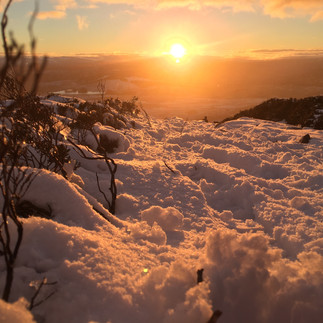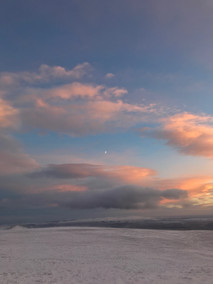Munro Bagging
- Fabian Seymour
- Feb 1, 2022
- 12 min read
Updated: Feb 9, 2022
Munro Bagging. What’s that all about then?
When Sir Hugh Munro first published his Munros Table in 1891, little could he have guessed that completing ‘the Munros’ would take off as a phenomenon. At the time of writing (31.01.2022), there are 7,108 people who have climbed, walked, cycled or generally crawled up to the summit of every single one. They are known as Munroists or Compleators (the spelling mistake was first made when referring to the first to compleat the Munros, and has been kept ever since). Fabian compleated in August 2010 becoming the 4,610th Munroist.
Although Sir Hugh gave his name to the Munros, he died in 1919 needing to climb two more – The Inaccessible Pinnacle on Skye and Carn Cloich-Mhullin in the Southern Cairngorms (which has subsequently been reclassified as a Top). The Revd A.E. Robertson was the first to compleat all the Munros in 1901.
So what is a Munro?
The Munros are mountains in Scotland over 3,000ft (or less romantically, 914m) and there are currently 282.
The 3,000ft or above rule is pretty much the only criteria. This causes a few problems when you get subsidiary summits of 3,000ft or above that are too close to the highest point or not enough descent / re-ascent between them for them to be considered separate Munros (rather they are called Munro Tops and are not included as distinct Munros). As for what constitutes enough distance or descent / re-ascent is purely subjective and undefined.
There are a few areas of controversy such as on Beinn Eighe, the White Mounth (Lochnagar area) and Sisters of Kintail. One can argue that some of the Tops should be Munros given others with a similar distance/re-ascent are distinct Munros elsewhere, and argue that others shouldn’t for the same reason.
However, the Scottish Mountaineering Club are now in charge of the lists and as it stands there are 282 Munros. The last major revision was in 2009 when two Munros were demoted. Ben Nevis is Britain’s highest mountain and being in Scotland, the highest Munro.
If you’ve climbed Ben Nevis you are well on your way to being a Munro Bagger! Only 281 to go!
Munro Baggers
Challenging yourself to complete the Munros will take you on adventures you wouldn't believe and to some of the remotest parts of the Scottish Highlands. Some areas require a full expedition into some very remote but stunningly beautiful locations, and then you’re only at the start of a whole range of mountains.
“The Highlands” as a collective also underplays the sheer diversity of geology, terrain, flora and fauna that you will experience bagging the Munros. Over toward the west coast the mountains are rugged, rocky, steep and often have narrow ridges linking them together. At the extreme end of these are the infamous Aonach Eagach Ridge in Glencoe (with two Munros), An Teallach near Ullapool (also with two Munros) as well as the epic Black Cuillin Ridge on the Isle of Skye with 11 Munros – generally the terror of all baggers as it is the only place where you can’t escape serious scrambling, roped climbs and at least one abseil (on the Inaccessible Pinnacle which, despite its name is extremely accessible. On a good day there are usually several groups queueing patiently).
These pictures from Skye include the Inaccessible Pinnacle and various sections of the ridge.
Over toward the east, the Munros tend to be huge, vast and rounded. The Cairngorms typify these and although they generally lack the airy ridges (there are a few), they make up for it with vast distances and their own charm and huge spectacular beauty. Up on the Northern Cairngorms there are animals such as ptarmigan and mountain hare left over from the Ice Age that turn white each winter. This is the highest, coldest and windiest plateau in Britain. The Cairngorms have a special place in my heart. They may not have the ridges of the west but beyond the weather challenges, they have their own in terms of navigation over such huge distances. But you can walk for days in parts of it and not see another human.
These pictures from the Cairngorms include Cairngorm, Meall a' Bhuachaille and Loch Etchachan (the highest named loch in Britain).
I’ve recently found myself introducing myself to groups as ‘A professional Munro re-bagger’. And it’s true. I absolutely love the Munros.
I often get asked what my favourite one is and that’s a difficult one to answer. It depends on who I'm with, what season it is and what the weather is doing for the most part. One mountain can be benign with stunning views on one day or a hideously wet and scary place the next. They are however, all magnificent in their own way.
A favourite circuit is Beinn Liath Mor and Sgorr Ruadh from Glen Carron. The Munros themselves are spectacularly diverse both in vegetation and rock type with their own challenges which by themselves gives a truly rewarding and full day out. The Sgorr Ruadh approach takes you through a maze of lumps, bumps and squelchy ground. Descending to the first col involves a few steep and rough sections and then a scramble up to get around a lump which separates these two magnificent mountains.
Beinn Liath Mhor is absolutely sublime. It glows silver from shattered quartz in the right light. A wonderful undulating ridge takes you back with two further lower summits. On a good day you have the entire panorama of the Torridon giants that dominate the views North - Beinn Alligin, Liathach and Beinn Eighe. What's even better is you can get the train directly to Achnashellach Station where the walk starts.
These pictures show the wonderfully green approach to Sgurr Ruadh, the triple summit ridge of Beinn Liath Mor and Sgorr Ruadh from the Col between the two in the setting sun
The Fannaichs range consists of 9 Munros. They can be tackled over a series of walks or even in a day for the enthusiastic. This whole area is just spectacular. You start on the high plateau between Inverness and Ullapool around Braemore Junction - the split for the Fisherfields and Beinn Dearg range. Up here you get the views to Torridon, Beinn Dearg, An Teallach in it's spectacular razor-notched glory, and up to the far north.
The terrain through the main Glen follows good tracks for the most part and there are paths through most of the bouldery bits. But a lot of the area has another worldly wild quality that is almost pioneering about it. There is magic up here when the weather plays along. Wispy clouds, localised mysterious fog patches. It's my first suggestion to clients as an alternative when the Fisherfields are too wet.
Sgurr Mor is a stunning and elegant mountain. At 1,110m this is the highest point in this range. Most of the others are all hovering just below the 1,000m mark. Neighbouring Beinn Liath Mor Fannaich (my 200th Munro on my first round) gives the best views of it. Accessible yet remote, dramatic yet doable in a (very long) day, sweeping ridge lines, squelchy ground, good paths, boulders. It has a bit of everything...
These pictures show Sgorr Mor from Beinn Liath Mor Fannaich, the ridge up to Sgurr nan Clach Geala and pleasant walking in the area in summer
Despite the more popular Glencoe, Glens Shiel and Affric are absolutely jaw-droppingly beautiful. Steep, rugged, pointed and magnificent. They are "all or nothing" places. There aren't any short mountain days here.
We have the famous 5 sisters of Kintail, the 4 brothers, 3 cousins etc. One Munro Top - Sgurr na Spainteach was named after the Spanish following the battle of Glen Shiel when Spanish troops fought in the Jacobite rising.
This north Shiel ridge makes up the South Glen Affric mountains as to the north are a succession of Glens lined up in near parallel. To the South is the famous Glen Shiel Seven (you can do all 7 Munros in a monster day) and the Forcan Ridge.
There are tracks and the Munros to the east are far easier than the Western edge. But the North Shiel ridge / South Affric ridge is epic. With plenty of scrambling and some hair-raising knife edge ridges. Perhaps the only Munro which is a single Munro day walk is the epic Ciste Dubh, a stunning needle point summit with a dramatic ascent. It rewards you with spectacular views of Glen Shiel North ridge Munros and down into Glen Affric and beyond.
And there are mountains in every direction. It is an exciting place. It is a Munro-baggers paradise with 22 Munros on offer! And I love it.
These pictures show the South Glen Shiel Ridge and Forcan Ridge in spring, and the Forcan ridge in summer from afar.
So why bother bag them all?
On one hand you could say that it’s a bit of a geeky anorak thing to do. On the other, you are out in the mountains in all weathers, all seasons, ever developing your own skills and heading off to places few in Britain have or will ever see. Some folks see my winter pictures and exclaim “wow, is that the Himilaya?” to which I respond, “No, it’s Scotland in Spring. It’s just that you always go abroad to sit on a baking hot beach for your holidays. You don’t know what exists on this small island you live on”.
There are a few ‘popular’ Munros with the walkers equivalent of the M62 going up them (e.g. the tourist track on Ben Nevis and the queues for the summit photo which can be several hours long in summer; Ben Vorlich and Stuic a’ Chroin near Lochearnhead; Ben Wyvis near Inverness and Ben Lomond near Glasgow to mention a few). But others are remote. Others you can often spend a day exploring and only encounter one or two people if any.

There are days when your summit view is about 5 metres of grey cloud in all directions walking at 45 degrees so as not to be blown over by the wind, but others when you break through the cloud and look down on a sea of mist with summits poking through in all directions. There are days when the setting sun ignites the surrounding hills and you are given a pyrotechnic display. You’ll see all manner of birds and mammals as well as carnivorous plants (ok, insectivorous – forget your Venus Fly Trap, we have our own modest British versions) on your journeys and you’ll come to see the remaining wilderness in Britain as a magic escape from reality.
In Spring, ‘The Alpine Season’, there are often blue skies, warm temperatures in the glens yet the Munros remain snow-capped. There are no midges which blight most of the summer season in the highlands and it is stunningly beautiful. Autumn too can give some wonderfully crisp clear days walking. In the far north I’ve had a white-out blizzard on the summer solstice on Ben Klibreck (the second most northerly Munro).
The first two pictures show the Arrochar Alps in spring above the clouds, and the descent from Beinn a' Ghlo in winter with the snow glowing orange.
I’m probably making it sound very romantic. Don’t get me wrong – they are tough. There are no easy Munros. They all require commitment. The Black Cuillins on Skye can be absolutely terrifying on a wet day (and that’s almost every day on Skye). Winter snow which can arrive in September and throughout winter adds the real risk of avalanches. But the challenge makes getting back to the car that much more rewarding. Going to places so few have ever seen. Reconnecting with planet Earth heading off for a few days with everything you’ll need to survive in your rucksack. Realising our human vulnerabilities in such an unforgiving environment.
There are folks who have done a continuous round of Munros with no motor assistance, people who have done night-time rounds, people who have done winter rounds, braving brutal storms and arctic conditions.
When I began my first round of Munros, I’d recently returned from working as a Nottingham Uni postdoctoral research scientist in the Antarctic. I joined a student mountaineering club and went on the freshers trip to Crianlarich in October. We spent two days getting freezing cold and soaking wet trudging through bogs. My kit was absolutely useless and I was completely dependent on our group leaders as I didn’t know one end of a compass from the other and even less about a map. Prior to that I’d been to Ben Nevis in June (about the worst time to go – midges) and trudged up the tourist track with a bit of A4 paper and a schematic diagram of the route I’d picked up from the visitor centre. Despite a horrible day getting wet and no views from the top, I bought this book called ‘The Munros’ by Cameron McNeish. Flicking through it were mountain ranges and names I’d never heard of let alone be able to pronounce in Scottish Gaelic. But it intrigued me…
I’d reached a point in my life where I needed a new challenge. It was hard to find anything that could compete with working in Antarctica. But I’d been vaguely taught how to use an ice axe and how to walk in crampons and wanted to keep those skills alive. It had been fun. I regularly went out for walks with a few colleagues in the Peak District, but I wanted a challenge. And doing the Munros sounded like a good one.
A wonderful quote by Hamish Brown (the first person to do a continuous round of the Munros in one outing) summed up my feelings: "We are given only one life. Surely its days are to be spent rather than hoarded, and given rather than spent? Everything should go to grasp what is best while it can be meaningful. What use is "security" twenty years hence if that is all those years give? Life should be lived greatly from day to day."
(from Hamish's Mountain Walk)
I compleated just under 6 years later. By then I’d been taught by friends how to vaguely use a map and compass to the point that I could ‘lead’ groups. By nature of the academic term times, most of our trips were in the colder months – so I got to use my ice axe and crampons - or the club kit until I bought my own. I learnt about what kit worked and didn’t from the more experienced members, went on winter skills courses subsidised by the Students Union and in that time planned and went on some quite terrifying expeditions. They seemed a bit daft at the time “we can link these up and bag 15 Munros in 3 days” and proved to be absolutely impossible in blizzard conditions. Yet we set out and even if we didn’t complete our objective, then a lot of it.
I grew as a mountaineer. I learnt the hard way what worked and what didn’t. I even managed to set off and surf a slab avalanche. I was lucky. There were many times we were lucky. We didn’t really know any better – but we were lucky being alive to learn from it.
There is never a wasted day on a mountain. Turning back before bagging the summit for whatever reason is always hard. But it’s often the right decision. After all, the mountain will still be there long after anyone reading this is gone.
Toward the end of my round (about 50 left) I became single minded. I wouldn’t even go on a trip with mates if there wasn’t at least one Munro accessible from there that I ‘needed’. When I did finish, I vowed ‘no more tick-lists ever again’.
But something kept drawing me back. Friends would say “fancy a week up in the highlands, I still need to bag x, y or z”. And off I’d go. And before I knew it I’d done 50 of a possible second round. And I was hooked again. Hooked on the escapism. Hooked on the mountains. Drawn back by their beauty. Often seeing them for a second time in a different season or a different type or even time of day. Reconnecting.
Ben Chonzie in the southern highlands is reportedly the most boring Munro in almost all guidebooks. Well, it's true there is nothing technical about it and there is a ruddy great track all the way up it. It's not particularly steep and it's a bit of an L-shaped wide ridge.
I have very little memories of the first time I climbed this one. Perhaps it was just a typical Scottish summer day (wet and grey). But I arrived mid-afternoon from York on my birthday at the end of November and decided to have a bit of night nav practice. Not that I really got the chance to practice much. Higher up if there was a path it was buried under snow but the route is straight forward enough.
The drive along the small track to the usual parking place was probably the most technical as it was coated in black ice patches. But others had made it and there were a few cars parked up and folks returning as I pulled up. I got a few strange looks from people returning seeing this lonesome chap starting to head up the mountain in the fading light. But I had a brilliant evening. Not much cloud, the moon making an appearance and being treated to a pink - orange and purple light display in the sky and rebounding off the surround snow-capped hills. I was alone on the mountain. And it felt brilliant.
The wind was pretty howling though. I made it down to the level track before needing to turn the head torch on and by the last km it was properly dark. I think it took me 3-4h in total.
So if someone says a hill is boring, change the picture a bit as I did. I still remember this "boring" hill as a great evening out!
The most stunning evening on the most borning Munro.
I now have the absolute privilege to guide people over the Munros, to share my sense of awe, wonder and love for them. I train people in navigation to give them more confidence to go exploring themselves. I run winter skills courses for walkers wanting to experience the beauty of the snow and ice.
But we don’t conquer mountains. They allow us the privilege to climb them. We treat them with respect. The Highlands have a different feel from Snowdonia, the Yorkshire Dales or Lake District. They are bigger. More stretched out. And there are a lot more of them.
They can turn on us in a moment and envelope us in high wind and cloud. Their personalities are as changeable as the sands on the beach.
They awoke the call of the wild in me. A connection with the planet and my place in the Universe. And I keep going back.
And I will keep going back until I draw my last breath.












































